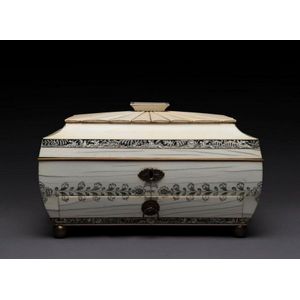Anglo-Indian Ivory Workbox with Intricate Carvings
An Anglo-Indian vizagapatam ivory workbox of sarcophagus form, with gadrooned cover and bands of leaves, birds and figures, interior beautifully fitted with sandlewood and ivory compartments, early 19th century, 19 cm high, 31 cm wide, 22 cm deep
You must be a subscriber, and be logged in to view price and dealer details.
Subscribe Now to view actual auction price for this item
When you subscribe, you have the option of setting the currency in which to display prices to $Au, $US, $NZ or Stg.
This item has been sold, and the description, image and price are for reference purposes only.
- Ivory - Ivory is a hard white material that comes from the tusks of elephants, mammoth, walrus and boar, or from the teeth of hippopotamus and whales. The ivory from the African elephant is the most prized source of ivory. Although the mammoth is extinct, tusks are still being unearthed in Russia and offered for sale.
Ivory has been used since the earliest times as a material for sculpture of small items, both in Europe and the east, principally China and Japan.
In Asia ivory has been carved for netsuke, seals, okimono, card cases, fan supports, animals and other figures and even as carved tusks.
In the last 200 years in Europe ivory has been used to carve figures, for elaborate tankards, snuff boxes, cane handles, embroidery and sewing accessories, in jewellery and as inlay on furniture. Its more practical uses include being used for billiard balls, buttons, and a veneers on the top of piano keys.
The use and trade of elephant ivory have become controversial because they have contributed to Due to the decline in elephant populations because of the trade in ivory, the Asian elephant was placed on Appendix One of the Convention on International Trade in Endangered Species (CITES), in 1975, and in January 1990, the African elephant was similarly listed. Under Appendix One, international trade in Asian or African elephant ivory between member countries is forbidden. Unlike trade in elephant tusks, trade in mammoth tusks is legal.
Since the invention of plastics, there have been many attempts to create an artificial ivory - Gadrooning - A series of lobes usually as a border. In furniture gadrooning is found as carved decoration around the edges of table tops in the Chippendale and Jacobean style furniture. Gadrooning is also found as decoration on the rims of silver and ceramics.
This item has been included into following indexes:
Visually similar items

Chinese inside painted snuff bottle, signed Ye Zhongsan (1869-1945) and dated 1932, dedicated to Lan Ping (stage name of Jiang Qing, Mao Zedong?s wife). Height 7.5 cm
Sold by
in
for
You can display prices in $Au, $US, $NZ or Stg.

Sold by
in
for
You can display prices in $Au, $US, $NZ or Stg.

An antique enamel Alliance Assurance Co. sign wear to the border. Height 40.7 cm. Width 51 cm
Sold by
in
for
You can display prices in $Au, $US, $NZ or Stg.

A group of English blue & white pottery, comprising; Stoke on Trent 'Willow' charger, old Chelsea, Wedgwood and others platters 41 & 40 cm wide
Sold by
in
for
You can display prices in $Au, $US, $NZ or Stg.
